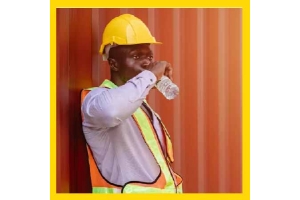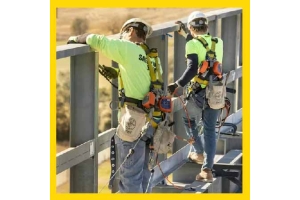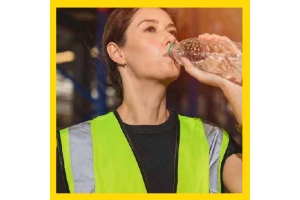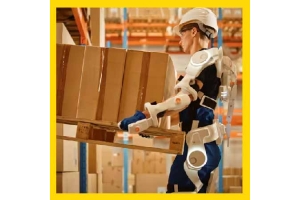Currency
May 05, 2019

Clever clothing innovations are making PPE use more acceptable, with more versatile applications.
Workplace safety is one of the major concerns that has been successfully driving the international industrial protective clothing fabric market. Today, from hard hats to steel-toed boots, personal protective equipment, often known as PPE, is keeping workers safe from head to toe. PPE has also been successful in keeping employees safe and has also been acting as the last line of defence against injury or death.
Development of new products are expected to give the market growth a boost and the progress is driven by various factors such as growing concern towards workers’ safety along with stringent governmental regulations, persistent growth in demand for protective clothing from various end-user industries, and extensive investments in research and development.
However, the high price of protective clothing and a constant threat of substitution can act against the growth of the market during the forecast period. Protective clothing in industries such as oil and gas and pharmaceuticals will offer significant opportunities for manufacturers and an upsurge in demand from emerging economies such as South Korea, China, India and Brazil are expected to thrust the growth.

Industrial protective clothing market analysis Growing workplace hazards and increasing worker safety are the major factors that are expected to drive industry growth for the next decade in various industrial sectors such as oil and gas, manufacturing, chemical, and food processing. Plus, increasing industrial fatalities and awareness towards the health and safety of workers’ is also expected to contribute to the market growth. In fact, for many industries, it is mandatory to comply with rules regarding workers’ safety at the workplace. Europe and North America are the major drivers for industrial protective clothing along with the Asia Pacific and the Middle East. The stringent regulations to follow the rules and guidelines in these countries are making it mandatory for industries to take care of their worker’s safety on account of increasing hazards. Additionally, upper management in most of the industrial firms is taking proactive measures to uphold workers’ safety at the respective workplace.
Today many companies are putting emphasis on raw materials that offer material features such as lightweight, higher heat resistance, comfort, and wear and tear resistance. This initiative is to achieve multi-functionality of protective clothing and increase its application scope. However, one of the challenging factors can be the rising costs of crucial materials such as aramid fiber, carbon fiber, and silicates.
In 2015, the global protective clothing market was valued at $8 million. This is expected to reach $10.2 million by 2022, supported by Compound Annual Growth Rate (CAGR) of 3.6% during the forecast period 2016 to 2022. Innovative trends in the market
Protective clothing is manufactured from fabrics that help in protecting the workers daily from being exposed to extreme heat, flame, molten metal, and arc flash. The protective clothes are designed to prevent contact with hazards or adverse elements of the environments. Protective clothing markets are mostly categorized based on the material type, namely, polyamide, aramid and blends, PBI, Polyolefin and blends, UHMW polyurethane and others. Let’s now take a look at some of the innovative trends in the industrial protecting market.
Soaring Demand for non-woven PPE: Breathability, comfort, high-tensile strength, and fire and water resistance are some of the qualities that nonwovens offer. They have also been playing a pivotal role in protecting medical professionals against the exposure to bloodborne pathogens, and shielding trained professionals against the risk of chemical exposure and hazardous materials and conditions.
Wearable technology: Wearable technology is becoming increasingly prevalent in PPE to enhance safety management and increase productivity at the worksite. The sensors that monitor gas, chemical, heat, sound, and UV are integrated into PPE and clothing to improve workplace safety. The technology alerts the users to danger in time for preventative steps. Wearable technology is also successful in offering long-term cost savings by preventing accidents on site.
Coldwear, a clever jacket: This jacket developed in Norway, monitors workers’ health levels when they work in extreme cold. The readings of body temperature, humidity, and perspiration both inside and outside the suit, along with tracking the location of the worker are recorded. Coldwear, designed for arctic oil fields, goes a long way in protecting the workers in a harsh environment by sending information back to a central point. Furthermore, the clothing can detect gas leaks and other harmful substances which may endanger your workers.
Multifunctional textile for advanced personal protective equipment: In partnership with Luna Innovations and Vertical Source, Inc., the Department of Homeland Security Science and Technology Directorate (S&T) developed a lightweight base ensemble that could be worn on a daily basis. This protective equipment is capable of providing protection against multiple hazards for a limited period of time. The multilayer textile system consists of:
An antimicrobial textile treatment, a protection against a range of bacteria.
A chemical protective membrane
Flame resistance textile layer
Tear protection layer
Lightweight and breathable clothing: Workers often carry around a lot of gear, and the last thing they need is a hot and heavy coat. The lighter protective apparel and equipment is a strong need for most workers across the globe. In fact, this need has been the driving force behind a significant number of innovations in the textile, garment and face-shield design. Today, environmentally controlled PPE is another developing technology that helps in keeping the body’s core temperature consistent while ensuring that workers are comfortable. These environmentally controlled PPE have been successful in protecting the workers from heatstroke to frostbite.
Besides, lightweight garments have gained significance in recent times. The textile innovations and the availability of high-performance yarns and treatments have made it possible to produce technically proficient PPE with different levels of thermal and chemical protection and water and fire resistance. For those considering cost-effective solutions, the durability of these testifies while ensuring value for money.
Soaring demand for disposable protective clothing: Used for protection from low to medium level hazards such as fluid handling in a cleanroom or laboratories, disposable industrial protective clothing is expected to generate revenue exceeding $1.3 million by 2022. These products are designed to comply with all the environmental standards and can be easily disposed of. Some of the areas where disposable protective clothing can be used are disaster response, hazardous waste management, specialist laboratories, emergency services, sewage treatment, and drainage construction.
Choosing not to wear PPE can be dangerous in the workplace when it could keep you protected. Workplace safety is essential and in-depth knowledge of these various protection devices can help in preventing hazardous injury.
Workplace safety is one of the major concerns that has been successfully driving the international industrial protective clothing fabric market. Today, from hard hats to steel-toed boots, personal protective equipment, often known as PPE, is keeping workers safe from head to toe. PPE has also been successful in keeping employees safe and has also been acting as the last line of defence against injury or death.
Development of new products are expected to give the market growth a boost and the progress is driven by various factors such as growing concern towards workers’ safety along with stringent governmental regulations, persistent growth in demand for protective clothing from various end-user industries, and extensive investments in research and development.
However, the high price of protective clothing and a constant threat of substitution can act against the growth of the market during the forecast period. Protective clothing in industries such as oil and gas and pharmaceuticals will offer significant opportunities for manufacturers and an upsurge in demand from emerging economies such as South Korea, China, India and Brazil are expected to thrust the growth.

Industrial protective clothing market analysis Growing workplace hazards and increasing worker safety are the major factors that are expected to drive industry growth for the next decade in various industrial sectors such as oil and gas, manufacturing, chemical, and food processing. Plus, increasing industrial fatalities and awareness towards the health and safety of workers’ is also expected to contribute to the market growth. In fact, for many industries, it is mandatory to comply with rules regarding workers’ safety at the workplace. Europe and North America are the major drivers for industrial protective clothing along with the Asia Pacific and the Middle East. The stringent regulations to follow the rules and guidelines in these countries are making it mandatory for industries to take care of their worker’s safety on account of increasing hazards. Additionally, upper management in most of the industrial firms is taking proactive measures to uphold workers’ safety at the respective workplace.
Today many companies are putting emphasis on raw materials that offer material features such as lightweight, higher heat resistance, comfort, and wear and tear resistance. This initiative is to achieve multi-functionality of protective clothing and increase its application scope. However, one of the challenging factors can be the rising costs of crucial materials such as aramid fiber, carbon fiber, and silicates.
In 2015, the global protective clothing market was valued at $8 million. This is expected to reach $10.2 million by 2022, supported by Compound Annual Growth Rate (CAGR) of 3.6% during the forecast period 2016 to 2022. Innovative trends in the market
Protective clothing is manufactured from fabrics that help in protecting the workers daily from being exposed to extreme heat, flame, molten metal, and arc flash. The protective clothes are designed to prevent contact with hazards or adverse elements of the environments. Protective clothing markets are mostly categorized based on the material type, namely, polyamide, aramid and blends, PBI, Polyolefin and blends, UHMW polyurethane and others. Let’s now take a look at some of the innovative trends in the industrial protecting market.
Soaring Demand for non-woven PPE: Breathability, comfort, high-tensile strength, and fire and water resistance are some of the qualities that nonwovens offer. They have also been playing a pivotal role in protecting medical professionals against the exposure to bloodborne pathogens, and shielding trained professionals against the risk of chemical exposure and hazardous materials and conditions.
Wearable technology: Wearable technology is becoming increasingly prevalent in PPE to enhance safety management and increase productivity at the worksite. The sensors that monitor gas, chemical, heat, sound, and UV are integrated into PPE and clothing to improve workplace safety. The technology alerts the users to danger in time for preventative steps. Wearable technology is also successful in offering long-term cost savings by preventing accidents on site.
Coldwear, a clever jacket: This jacket developed in Norway, monitors workers’ health levels when they work in extreme cold. The readings of body temperature, humidity, and perspiration both inside and outside the suit, along with tracking the location of the worker are recorded. Coldwear, designed for arctic oil fields, goes a long way in protecting the workers in a harsh environment by sending information back to a central point. Furthermore, the clothing can detect gas leaks and other harmful substances which may endanger your workers.
Multifunctional textile for advanced personal protective equipment: In partnership with Luna Innovations and Vertical Source, Inc., the Department of Homeland Security Science and Technology Directorate (S&T) developed a lightweight base ensemble that could be worn on a daily basis. This protective equipment is capable of providing protection against multiple hazards for a limited period of time. The multilayer textile system consists of:
Lightweight and breathable clothing: Workers often carry around a lot of gear, and the last thing they need is a hot and heavy coat. The lighter protective apparel and equipment is a strong need for most workers across the globe. In fact, this need has been the driving force behind a significant number of innovations in the textile, garment and face-shield design. Today, environmentally controlled PPE is another developing technology that helps in keeping the body’s core temperature consistent while ensuring that workers are comfortable. These environmentally controlled PPE have been successful in protecting the workers from heatstroke to frostbite.
Besides, lightweight garments have gained significance in recent times. The textile innovations and the availability of high-performance yarns and treatments have made it possible to produce technically proficient PPE with different levels of thermal and chemical protection and water and fire resistance. For those considering cost-effective solutions, the durability of these testifies while ensuring value for money.
Soaring demand for disposable protective clothing: Used for protection from low to medium level hazards such as fluid handling in a cleanroom or laboratories, disposable industrial protective clothing is expected to generate revenue exceeding $1.3 million by 2022. These products are designed to comply with all the environmental standards and can be easily disposed of. Some of the areas where disposable protective clothing can be used are disaster response, hazardous waste management, specialist laboratories, emergency services, sewage treatment, and drainage construction.
Choosing not to wear PPE can be dangerous in the workplace when it could keep you protected. Workplace safety is essential and in-depth knowledge of these various protection devices can help in preventing hazardous injury.









